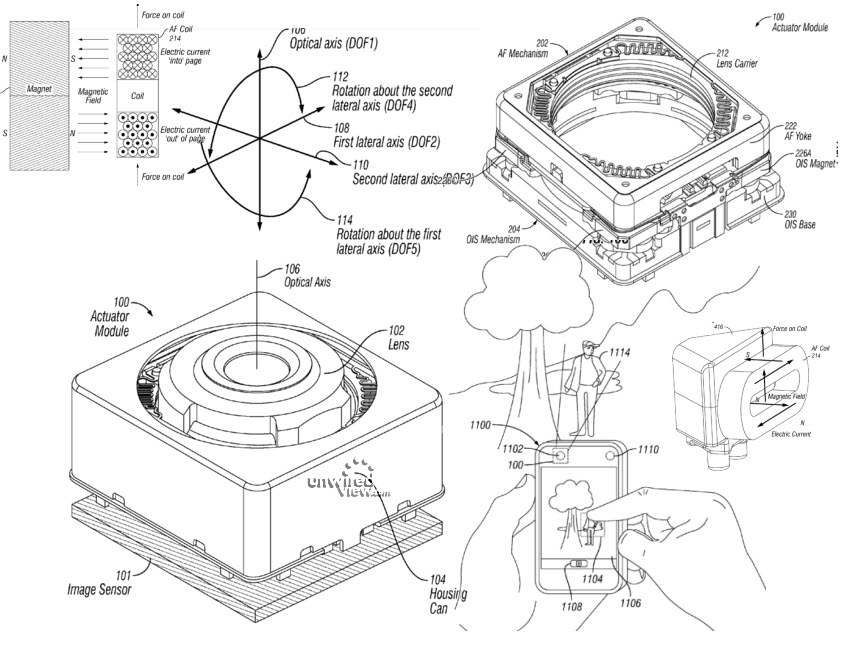
A recent patent application reveals that Apple is working on bettering the iPhone's camera with optical image stabilization and improved autofocus.
Spotted by UnwiredView, the patent entitled, "VCM OIS ACTUATOR MODULE", details a lens actuator module that includes an autofocus (AF) mechanism capable of moving a lens according to at least three degrees of freedom and an optical image stabilization (OIS) mechanism capable of moving the lens according to at least two degrees of freedom.
An embodiment of the invention is an actuator module suitable for use in a camera, more specifically, a miniature camera. The actuator module may include a mechanism to provide an AF function and a mechanism to provide an OIS function. In one embodiment, the AF mechanism may be configured with four separate magnets and four separate coils positioned around a lens carrier. Each coil can deliver a force on one corner of the lens carrier along the optical axis. In this way, if the four coils are driven appropriately with a common mode current they can provide the forces needed to focus the lens. However, if driven differentially, they can actively tilt the lens to compensate for parasitic lens tilt.
The actuator module would also incorporate an OIS mechanism to shift the lens carrier in directions orthogonal to the optical axis.
"Such motions can substantially correct for handshake motions in the center of the image. Using this method of OIS, the associated image sensor substrate can remain stationary, substantially simplifying the camera manufacture, size and packaging in the mobile handheld device."
The combination of the autofocus mechanism and optical image stabilization mechanism within a single actuator module allows it to modify the position of the lens relative to the image sensor along five difference axes.
More details on how the actuator works can be found at the link below. Of course, it's not a guarantee that Apple will debut this technology in the next iPhone; however, the company has made improvements to the phone's camera with each generation. Let's hope the iPhone 6 launches with OIS!
Read More [via UnwiredView]

Spotted by UnwiredView, the patent entitled, "VCM OIS ACTUATOR MODULE", details a lens actuator module that includes an autofocus (AF) mechanism capable of moving a lens according to at least three degrees of freedom and an optical image stabilization (OIS) mechanism capable of moving the lens according to at least two degrees of freedom.
An embodiment of the invention is an actuator module suitable for use in a camera, more specifically, a miniature camera. The actuator module may include a mechanism to provide an AF function and a mechanism to provide an OIS function. In one embodiment, the AF mechanism may be configured with four separate magnets and four separate coils positioned around a lens carrier. Each coil can deliver a force on one corner of the lens carrier along the optical axis. In this way, if the four coils are driven appropriately with a common mode current they can provide the forces needed to focus the lens. However, if driven differentially, they can actively tilt the lens to compensate for parasitic lens tilt.
The actuator module would also incorporate an OIS mechanism to shift the lens carrier in directions orthogonal to the optical axis.
"Such motions can substantially correct for handshake motions in the center of the image. Using this method of OIS, the associated image sensor substrate can remain stationary, substantially simplifying the camera manufacture, size and packaging in the mobile handheld device."
The combination of the autofocus mechanism and optical image stabilization mechanism within a single actuator module allows it to modify the position of the lens relative to the image sensor along five difference axes.
More details on how the actuator works can be found at the link below. Of course, it's not a guarantee that Apple will debut this technology in the next iPhone; however, the company has made improvements to the phone's camera with each generation. Let's hope the iPhone 6 launches with OIS!
Read More [via UnwiredView]






0 comments:
Post a Comment